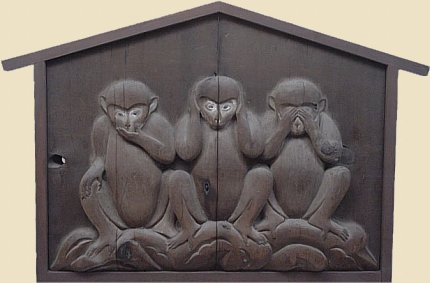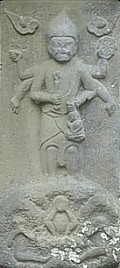|
|
|
|
 PAGE ONE OF FOUR PAGE ONE OF FOUR

 | 2 | 3 | 4 | 2 | 3 | 4

MONKEY IN JAPAN
PAGE ONE - STORY SNAPSHOT
Calculating and intelligent, yet
mischievous, vain, and restless.
Akin to the human spirit and passions.
Common motif in Buddhist art & literature.
ORIGINS
India: Hindu Lore (Pre-Buddhist) & Buddhism
China: Zodiac Lore (Pre-Buddhist) & Buddhism
Japan: Buddhist and Shintō Lore


Three Monkeys. Jp. = San-en 三猿 or Sanzaru 三猿 or Sanbiki no Saru 三匹の猿.
Wood Carving, 1646 AD. Treasure of Hase Dera Temple in Kamakura, Japan
Speak No Evil (Iwazaru 言わざる), Hear No Evil (Kikazaru 聞かざる), See No Evil (Mizaru 見ざる)

|
STORY SNAPSHOT
QUICK SUMMARY OF ALL MONKEY PAGES
|
|

|

Kōshin Statue, 1808 AD
Shōmen Kongō standing
atop three monkeys

Sacred Monkey at
Hie Shrine, Mt. Hiei
Shiga Pref., Japan
|
|
 These four pages focus on monkey lore and monkey deities in India, China, and Japan -- with a special emphasis on Japanese Tendai Shinto-Buddhism. They also present many examples of monkey artwork found in Japan. In both Hindu lore (India) and Zodiac divination (China), we find examples of monkey mythology that predate the arrival of Buddhism. The latter originated around 500 BC in India and took hold in China sometime in the 1st-2nd centuries AD. These four pages focus on monkey lore and monkey deities in India, China, and Japan -- with a special emphasis on Japanese Tendai Shinto-Buddhism. They also present many examples of monkey artwork found in Japan. In both Hindu lore (India) and Zodiac divination (China), we find examples of monkey mythology that predate the arrival of Buddhism. The latter originated around 500 BC in India and took hold in China sometime in the 1st-2nd centuries AD.
By the time Buddhism reached Japan (mid 6th century AD), the monkey and monkey lore were already common elements in Buddhist legend, art, and iconography. Thereafter, monkey worship in Japan grew greatly in popularity, especially among practitioners of Taoist Kōshin rites introduced from China and among followers of Tendai Shintō-Buddhism, the latter centered around the syncretic Tendai shrine-temple multiplex located at Mt. Hiei (Shiga Prefecture, near Kyoto). Some scholars believe the famous three monkeys -- speak no evil, hear no evil, see no evil -- originated in Japan in association with Mt. Hiei and the sacred monkey of the Hie Shrine (Hie Jinja 日吉神社; also called Hiyoshi Taisha 日吉大社).
The central deity at Mt. Hiei is Sannō 山王 (lit. Mountain King; also spelled Sannou, Sanno, Sanoo, Sano), an appellation given to all Shintō deities protecting this sacred mountain. Sannō’s messenger (tsukai 使い) is the monkey. The Sannō deity is broadly conceived, for Sannō actually represents three important Buddha (Shaka, Yakushi, and Amida), who in turn represent the three most important Shintō KAMI (deities) of Hie Shrine. These three Kami are Omiya 大宮, Ninomiya 二宮, and Shōshinshi 聖真子. Collectively, there are 21 Sannō deities at Mt. Hiei, each associated with a specific Buddhist counterpart. These manifestations of the Sannō deity are called Hie Sannō Gongen 日吉山王権現 (Mountain King Avatars of Hie Shrine). Moreover, the number three is of tremendous importance in Tendai doctrine. This supports the notion (still contested) that the three-monkey motif originated in Japan in association with Mt. Hiei and Tendai Shintō-Buddhism.
Monkey worship in Japan peaked in the Edo Era, but has declined significantly since then. Even so, the legacy of monkey faith is easily spotted in modern Japan. One can still find old stone statues with monkey motifs in many Japanese localities -- statues that are weathering away, unprotected from the elements. Photos of these statues are presented on Page Three. Moreover, certain Japanese shrines (Hie Jinja locations nationwide) and temples (Shitennō-ji in Osaka) continue even today to perform the Kōshin rites for those who still believe (most are elderly Japanese), and lucky charms featuring the monkey are still easily found at Japanese temples, shrines, and trinket shops. The color RED is often associated with the monkey, for it signifies the dual role of the monkey as protector against disease as well as patron of fertility. |

PAGE STRUCTURE:
These pages are organized in four categories to improve readability.
- Page One. Story Snapshot. This page! Quick summary of story.
- Page Two. India & China. Pre-Buddhist monkey mythology. Focus on Hindu lore (India) and Zodiac cosmology (China). Also explores subsequent Buddhist monkey lore in both nations. Key topics include the Hindu legend of Hanuman, various stories from the Jataka, the Chinese novel “Journey to the West,” and the Chinese parable “Catching the Moon’s Reflection.”
- Page Three. Japan. The central page of this report on the monkey. Explores monkey lore and monkey deities in Japan. Features many photos of extant Japanese artwork, with a special focus on Japanese Tendai Shinto-Buddhism, Mt. Hiei, Sannō, Kōshin, the three worms, Shōmen Kongō, and the three monkeys. The following deities and concepts appear on page three:
Three Monkeys = San-en 三猿 or Sanzaru 三猿 or Sanbiki no Saru 三匹の猿. Literally means "Three Monkeys," who are Mizaru (no see, 見ざる), Kikazaru (no hear, 聞かざる), and Iwazaru (no speak, 言わざる)
Jūzenji (Juuzenji) = 十禅師
Kōshin (Koushin, Koshin = 庚申
Kanoe Saru = 庚申
Masaru = 神猿
San-en = 三猿 = Three Monkeys
Sannō (Sannou, Sanno, Sano) Gongen = 山王権現
Sannō (Sannou, Sanno) Mandala = 山王曼荼羅
Sarugami = 猿神 (Also search 猿神の舞い)
Sarutahiko = 猿田彦
Seishoku Daikongō (Daikongo) Yasha = 青色大金剛薬叉
Shikumon Setsuki 四句文刹鬼 and Shima 四魔
Shinra Myōjin (Myoujin) = 新羅明神
Shōmen Kongō (Shomen Kongo) = 青面金剛
Three Worms = 三蟲 (or three corpses/destroyers 三尸)
- Page Four. Sources. Bibliography and targeted resources for learning more. Also includes a special section on Chinese and Japanese monkey adages and phrases.

 JUMP TO PAGE TWO JUMP TO PAGE TWO
|
|